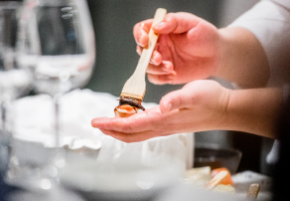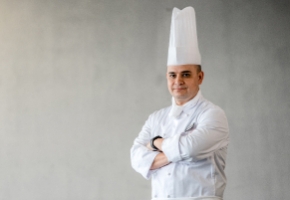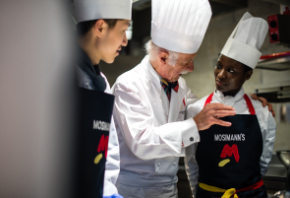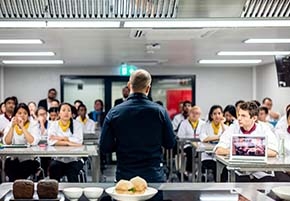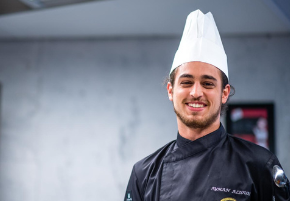- About
- Programs
- Campus Life
- Career Services
- Admissions
- News & Events
- Alumni
Top Grilling Techniques for Juicy, Flavorful Results
Discover essential grilling techniques for perfect BBQ every time. Learn tips, tools, and methods to grill like a pro. Start mastering your grill today!
Key Takeaways
- Grilling success depends on mastering heat control and matching techniques to the right foods.
- Methods like two-zone cooking, reverse searing, smoking, and plank grilling expand flavor and precision.
- The choice of equipment can completely change the flavor, texture, and style of a dish.
- Safety in fire management, food handling, and equipment care is the foundation of professional grilling practice.
Since the earliest days of human survival, grilling has been a way of turning raw catch into something nourishing and flavorful. For many, it remains the most satisfying way to savor food, carrying with it the aroma of smoke and the pleasure of shared meals.
Grilling carries that same ancestral spirit, but it has also grown into a practice of technique and choice. Cooking over fire isn't only a matter of placing food on the grate and letting heat do the work. Instead, the grilling techniques used determine the entire character of the dish.
Key Grilling Techniques
Understanding different grilling techniques will elevate your cooking from amateur to a professional level. These approaches open up a wide range of possibilities, each suited to particular ingredients and to the result you want to bring out on the plate.
Start Your Culinary Journey
Learn the art of cooking in a world-class environment
Direct vs. indirect grilling
Direct grilling is the technique most associated with flame and char. Food sits directly above the heat source, creating the high temperatures needed to sear and caramelize quickly. Steak cuts, burgers, vegetables, and thinner cuts of fish are some of the best food choices for this method because the heat locks in juices while marking the surface with that unmistakable grilled character.
To use direct grilling:
- Preheat your grill to medium-high or high heat.
- Place food directly over the heat source.
- Cook for shorter periods, turning once or twice.
- Monitor closely to prevent burning.
Indirect grilling shifts the relationship between fire and food. Instead of intense heat from below, the food rests to the side, allowing warmth to circulate much like an oven. This approach is better suited to larger or more delicate items that need time to cook through evenly without burning, like whole chickens, thick roasts, pork chops, or fillets of fish.
For indirect grilling:
- Light only half your gas burners or push coals to one side.
- Place food on the cooler side of the grill.
- Close the lid to create convection cooking.
- Allow longer cooking times at lower temperatures.
Controlling heat and temperature
Mastery of grilling begins with control over the fire itself. The flavor, texture, and even safety of food depend on it. Too much intensity scorches the outside while leaving the inside raw; too little and ingredients dry out before reaching their peak.
Professional chefs often describe temperature control as the language of the grill; every adjustment of flame, coal, or vent communicates something to the food.
At Culinary Arts Academy Switzerland (CAAS), instructors remind students that this level of control is as much about discipline as technique. As Kozlov, a CAAS alumnus, explained:
The teachers at Culinary Arts Academy challenge your thinking... Beyond cooking skills, we are taught high professional standards, organization, and the use of kitchen tools – all while paying attention to every single detail.
Some of the most useful tools that can help with temperature control when grilling are:
- Instant-read or built-in thermometers
- Vents and dampers on charcoal grills
- Burner knobs on gas grills
- Heat-resistant gloves
- Grill baskets and hinged grates
- Chimney starters
- Cast iron grill grates or pans
Two-zone cooking
Building on the idea of temperature control, two-zone cooking takes the concept further by deliberately dividing the grill into separate areas of heat. Instead of relying on one uniform surface, you can create a space for high, direct heat and another for gentler, indirect heat.
Two-zone cooking gives you the flexibility to sear, cook through evenly, and keep food warm without overcooking. Professional chefs use this approach instinctively, mirroring the way they manage different burners and ovens in a kitchen.
To set up two zones, you should:
- Create a hot zone directly over high heat for fast searing.
- Establish a cooler zone with indirect medium heat for slower, gentler cooking.
- Use the hot zone first to develop color and flavor.
- Move food to the cooler zone to finish cooking evenly.
Searing for flavor
Searing is the technique used to achieve that unmistakable grilled taste. It triggers the Maillard reaction, a natural process that turns proteins and sugars into a golden crust packed with rich, layered flavor. High heat and precise timing make all the difference, giving every bite the intensity that defines great grilling.
To achieve professional-quality searing results, make sure to do the following:
- Heat the grill grates until they are clean and very hot, ensuring food makes direct contact with the heat.
- Pat proteins dry with paper towels, removing excess moisture that would interfere with browning.
- Season the food just before grilling, preserving the crust's texture and flavor balance.
- Place the food on the grill and leave it in place, allowing enough time for proper browning rather than moving it too soon.
- Listen for the steady sizzle, which signals that the surface is searing at the right temperature.
Reverse searing
Thick steaks and other similar cuts of meat benefit from a slower start before being finished with intensity. Reverse searing flips the usual approach by gently cooking proteins first, then applying high heat at the end. This guarantees even doneness throughout while still creating a flavorful crust.
To carry out the reverse sear, follow these steps:
- Begin with indirect, low heat between 121–135°C (250–275°F).
- Cook until the internal temperature reaches about 5–8°C (10–15°F) below your target.
- Transfer to direct, high heat for a quick sear that builds color and flavor.
- Rest the meat briefly before serving to let juices redistribute.
Smoking and slow cooking
Smoking is one of the oldest and most distinctive grilling techniques, built on the principle of gentle heat sustained over time. Instead of rushing the process, food is left to cook slowly as wood smoke seeps in, transforming firm cuts into tender, richly flavored meals. The key is steady control of both temperature and smoke.
Brisket, pork shoulder, ribs, and whole chickens are some of the foods most commonly grilled using this technique.
To achieve success with smoking, keep in mind these principles:
- Maintain consistent low heat between 107–121°C (225–250°F).
- Add wood chips or chunks to build distinct flavor profiles.
- Allow extended cooking times so collagen and fibers break down fully.
- Monitor internal temperature as your true guide, not the clock.
- Keep the lid closed to hold steady heat and smoke inside.
Plank grilling
Cooking on a wooden plank changes the way food meets heat. Instead of sitting directly on the grates, ingredients rest on a soaked cedar board that slowly smolders as it warms. The wood gives off a gentle aroma that blends into the food while also keeping it safe from scorching flames.
This technique is a variation of cooking methods used by Indigenous communities of the Pacific Northwest and has since become a favorite for adding natural flavor to fish and vegetables.
To prepare a cedar plank for grilling, make sure you:
- Soak cedar planks in water for at least one hour before cooking.
- Preheat the plank briefly on the grill for two to three minutes.
- Arrange seasoned fish or vegetables on the hot plank.
- Close the lid and cook with indirect heat, allowing the plank to smolder gently without catching fire.
Rotisserie grilling
Rotisserie grilling turns food slowly over the fire, allowing every side to cook evenly while the surface turns golden and crisp. The steady rotation acts as a natural baster, keeping the meat juicy inside as the exterior develops a rich crust. Whole chickens, legs of lamb, and pork roasts are classic choices for this technique.
To set up a successful rotisserie cook, make sure to:
- Secure proteins tightly on the spit to prevent shifting during rotation.
- Balance the weight so the spit turns evenly.
- Cook with indirect heat surrounding the food instead of flames beneath it.
- Baste periodically to add flavor and moisture.
- Check internal temperatures carefully before serving.
Foil packet grilling
Cooking with foil packets creates a sealed pouch where steam circulates, keeping ingredients moist while blending flavors. It's a technique especially suited to delicate foods like fish, vegetables, or dishes with sauces, since the foil protects them from direct flames.
To assemble effective packets, follow these steps:
- Use heavy-duty foil to prevent tearing.
- Add a splash of liquid such as broth, wine, or oil to generate steam.
- Season ingredients generously before sealing the packet.
- Fold and crimp edges tightly so steam does not escape.
- Cook over medium heat and allow enough time for flavors to meld without burning.
Vegetable basket grilling
A grill basket makes it easy to cook smaller or delicate ingredients that might otherwise slip through the grates. The basket holds vegetables together, letting heat and smoke circulate while keeping everything in place.
This technique works especially well for asparagus, peppers, mushrooms, or mixed vegetable medleys, delivering smoky flavor while keeping prep and cleanup simple. To properly use vegetable basket grilling, you should:
- Cut vegetables into uniform sizes so they cook evenly.
- Lightly coat with oil and season before placing them in the basket.
- Shake or stir the basket occasionally to prevent sticking and encourage even browning.
- Grill over medium to medium-high heat until tender and lightly charred.
Salt slab grilling
A Himalayan salt slab is a block of crystallized pink salt, cut thick enough to withstand direct heat. When heated slowly, it becomes a cooking surface that seasons food naturally while maintaining steady, even heat. Unlike a metal grate, the slab also imparts subtle mineral flavors and creates an impressive presentation at the table.
This technique is especially popular for seafood, thin cuts of meat, and even fruits, since the salt adds complexity while protecting delicate ingredients from harsh flames.
To cook on a salt slab, you should:
- Preheat the slab slowly on the grill to avoid cracking.
- Lightly oil the surface once it reaches high heat.
- Place meats, seafood, or vegetables directly on the hot slab.
- Turn food as needed while it cooks, absorbing subtle seasoning from the salt.
- Allow the slab to cool gradually before cleaning and storing.
Brick grilling (Press method)
Brick grilling is a traditional technique that uses weight to hold food flat against the grill. The steady pressure encourages even browning, keeps the surface in contact with the heat, and produces crisp skin without drying out the meat. It's especially popular for dishes like chicken or pressed sandwiches, where the contrast of seared exterior and tender interior makes each bite stand out.
To use this technique, you must:
- Wrap a clean brick in foil to keep it safe for cooking.
- Place the food directly on the grill.
- Set the foil-wrapped brick on top to press the food firmly against the grates.
- Cook until the underside is browned, then turn and repeat for the other side.
Direct over coals (Caveman style)
Caveman grilling, true to its name, skips the grates and puts food directly on glowing embers. This technique is raw and elemental, producing a smoky edge and a crust so deep it feels like fire itself has seasoned the meat.
To grill caveman style:
- Burn hardwood charcoal until it forms a glowing bed of embers.
- Brush or shake away excess ash to keep the surface clean.
- Lay thick steaks or chops directly on the embers.
- Cook for a few minutes per side, then brush off any ash before serving.
Safety Tips for Grilling
Professional food safety standards are non-negotiable in culinary practice. At CAAS, repetition turns those standards into instinct, training students until the routines feel like muscle memory. That preparation matters most in real kitchens, where hesitation isn't an option.
As Malak, one of our graduates, explained, "I especially appreciate the way the chefs taught us by putting us in high-pressure situations. They truly showed us how to survive in the real world." He added that without this training, he doubts he could have lasted in the industry.
Safety in grilling comes down to three things: controlling the fire, protecting the food, and caring for the equipment.
Fire and heat safety
The fire is your greatest tool, but also the greatest risk. To keep it under control, make sure to:
- Keep a fire extinguisher or water source nearby in case of emergencies.
- Never leave a hot grill unattended, even for a moment.
- Ventilate gas grills properly to prevent dangerous buildup.
- Check gas connections regularly for leaks.
- Clean grease traps often to avoid sudden flare-ups.
Food safety protocols
Food safety protects both flavor and health. To guarantee it, rely on habits such as:
- Use separate cutting boards for raw proteins and cooked foods.
- Wash your hands frequently during preparation.
- Cook proteins to safe internal temperatures to ensure doneness.
- Discard marinades that touch raw meat instead of reusing them.
- Keep cold foods chilled until they're ready for the grill.
Equipment maintenance
A well-maintained grill is safer and more reliable. To properly care for your grilling equipment, keep in mind tips such as:
- Clean grill grates after every use to prevent buildup.
- Replace worn or damaged parts before they cause hazards.
- Store propane tanks upright in a safe, ventilated place.
- Inspect electrical connections on electric grills for wear.
- Season cast iron grates to protect them from rust.
Become a Master at Grilling
Mastery in grilling builds gradually, through repetition and guidance from skilled instructors. Professionals distinguish themselves by controlling heat and judging timing, but those fundamentals are only the beginning.
At CAAS, those principles form part of a larger education that spans every corner of the kitchen. Students refine techniques under chef instructors, apply them in professional service, and test themselves through global internships.
Business and leadership modules add another dimension, preparing graduates for careers that range from leading brigades to building ventures or teaching the next generation. Our BA in Culinary Arts program offers that full journey—where mastery of one skill or technique becomes the groundwork for mastering the craft as a whole.
Frequently Asked Questions
How can I tell if my food is fully cooked without cutting it open?
Use an instant-read thermometer to check internal temperatures: 74 °C (165 °F) for poultry, 63 °C (145 °F) for whole cuts of pork and beef (with a rest), 71 °C (160 °F) for ground meats, and 63 °C (145 °F) for fish for food safety.
Can I reuse charcoal after grilling?
Yes, extinguish charcoal by closing all vents and reuse partially burned pieces for your next grilling session, though you'll need to add fresh charcoal for full heat.
Interested in studying at CAAS? Download our brochure to learn about our programs!


